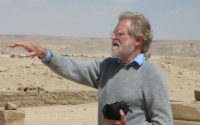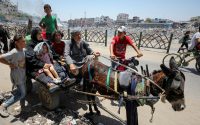The D-Day Battle France Chose to Forget. Until Now.
Some 170 miles southwest of the celebrated landing beaches in Normandy, the remains of a D-Day site few visit peek out from behind trees in rural Brittany.
Overgrown with moss and ivy, the stone farm buildings were the former headquarters of the Saint-Marcel Maquis — thousands of local French resistance fighters who had gathered in response to coded Allied calls over BBC radio to prepare for an invasion. Among them were French army commandos parachuted in to block the Nazis from sending reinforcements to the beaches.
But before the operation could be put into full swing, the camp was discovered by the Nazis and destroyed. Dozens of fighters were hunted down and killed. In retribution, most buildings in the surrounding area were burned and hundreds of locals were executed.
It’s a wound of tragic heroism that few in France know about, let alone commemorate.
President Emmanuel Macron of France aimed to change that when he presided over a ceremony on Wednesday in Plumelec, the nearby village where French commandos landed early in the morning of D-Day as the first Allied planes and gliders were arriving in Normandy. One of the members of that elite French unit, Émile Bouétard, was shot dead by soldiers with the German army. He is considered among the first Allied casualties of D-Day.
“The bravery and determination of these united fighters played a major role in the liberation of our country,” Mr. Macron said before the crowd gathered, braving intermittent rain spells typical of the region. “Their heroic actions leave an indelible mark on our history.”
The president’s visit — and accompanying history lesson — was the latest in a year of events planned to celebrate the country’s release from the Nazis’ grip 80 years ago. Unlike many of his predecessors, Mr. Macron has chosen to memorialize not only the valiant and brave, but also the shameful and forgotten — including a site where French resistance fighters were killed by French militia members who were working with the Nazi regime.
Some critics have derided the events as “memory inflation,” but others note that they come at a time when the country should be contemplating its past ghosts. The head of an advisory board of historians, Denis Peschanski, says the events are aimed at achieving “historical equilibrium.”
For many in this pocket of Brittany, the presidential homage came as a long-awaited recognition. The last French leader to visit the area for a ceremony was Gen. Charles de Gaulle in 1947 — and he was not president at the time.
“It’s a good thing,” said Marcel Bergamasco, the last Saint-Marcel fighter alive and able to recount his experience. He is 99. “It’s a recognition that what happened in Saint-Marcel mattered.”
Two former commandos from the French unit of the British Special Air Service, both nearing 100 years old, attended the ceremony. For their group, which numbered more than 400 dropped into Brittany over weeks, the moment also felt long overdue.
“For them to be finally recognized before they die, it feels very poignant,” said Claude Jacir, the president of the Association of Families of S.A.S. paratroopers with Free France. “They are the last keepers of memory. They really hope their history doesn’t fall into oblivion.”
Ask why this story is so little known in France, and you will get many reasons, including that it happened so far from Normandy, where most of the action took place. It also didn’t fit the mold.
The French paratroopers were lethal agents, trained to strike and then disappear. Their instructions were to blow up bridges, rail lines and telephone lines to confuse and detain the Nazis from rushing up to Normandy, then move on.
But when they arrived at the headquarters, which teemed with untrained volunteers from across the region, their leader felt obliged to stay. He radioed for backups to be parachuted in, along with many hundreds of containers of weapons and ammunition. Even four jeeps were floated down.
For more than a week after D-Day, the forested, 1,235-acre area dotted with cow pastures and manors in the region of Morbihan transitioned into a training camp.
After four years of occupation, the locals felt suddenly liberated. They called the area “Little France” and set up a sick bay, auto shop, cobbling service and field kitchen with bakers who prepared bread around the clock.
But early on the morning of June 18, the camp was discovered by a German patrol that sent armored reinforcements from around the region. After a day of fighting, the remaining paratroopers and resistance fighters were forced to flee into the woods. Some were hunted down and shot by enraged Nazis, who had suffered severe losses in the battle. The Nazis then took their fury out on the local residents.
Today one chilling memorial after another mark the roadsides. One honors three residents who were shot the day after the battle, including 83-year-old Françoise Le Blanc. Another commemorates two local women who were sent to Ravensbrück, a large concentration camp for women in northern Germany, as punishment.
The village at the center of the fighting, Saint-Marcel, had to be totally rebuilt after almost every building was burned down. A site off the main road marks where the bodies of six resistance fighters were discovered in an unmarked pit two decades after the war’s end.
“I had nightmares every night for 10 years,” said Jean-Claude Guil, 85, who has dedicated his retirement to researching the battle that cast a shadow over his life. His father, a local tenant farmer, was among those executed in vengeance.
Their D-Day story was so painful that most locals wanted to forget it for many years, said Tristan Leroy, the director of the nearby Brittany Resistance Museum.
“Some even said if there hadn’t been the organized resistance, they wouldn’t have burned all the farms and the village, and there wouldn’t have been all those executions,” he said. “There was an ambivalent feeling about what happened here.”
It wasn’t until the 1980s, in the face of the rise of the far-right National Front in France and statements by its leader, Jean-Marie Le Pen, downplaying the Nazi gas chambers as a “detail” of history, that former fighters began to speak out to remind people of Nazi atrocities, Mr. Leroy said. The museum was built around the same time.
“If we hadn’t had that battle, where would we be now?” Mr. Bergamasco said during an interview last month in the stone house he built in 1955 in Ploërmel, where he lives with his 97-year-old wife, Annette.
He is among the last resistance fighters still alive in France.
“I’m happy with what I did. I regret nothing at all,” he said.
Mr. Bergamasco was 15 in 1940 when, after just months of fighting, France signed an armistice and was occupied by German soldiers. His first acts of resistance were those of teenage fury — popping German tires with a shiv he carried in his pocket.
As a driver of a truck for his father’s construction company, he was often ordered to make deliveries for the Germans. He was recruited by the resistance to deliver intelligence on the German fortifications he visited. That information was later compiled into a hefty secret document with hand-drawn maps called the “Cherry Basket” and smuggled to Britain.
He used his hybrid truck, which ran on charcoal as well as gasoline, to deliver supplies to the resistance. Later, he became part of the Maquis truck squad, driving out at night to pick up the S.A.S. commandos and supplies that were descending from the sky.
When Mr. Bergamasco recounts stories from that time, it’s as if he is back in his teenage body and is experiencing them anew. He replays dialogue, impersonates characters and delights in outwitting and often outrunning the Germans.
Even the night he spent in jail, being tortured so badly he would later hemorrhage internally, he spins as another successful escape. “I see the front door opened. Oh! What more could one ask for?” he recounted, his blue eyes twinkling. “I hurtle down the stairs and I am off.”
But his memories of the battle of Saint-Marcel are dark. He recalls the sound of his wounded friends suffering in pain, and his helpless feeling of not being able to save them.
And since Russia attacked Ukraine, Mr. Bergamasco has been consumed by worry that the dictatorship he fought against is returning, said Yolande Foucher, one of his two daughters.
“It’s his nightmare,” she said.
After the ceremony, Mr. Macron laid flowers on the monument to 77 S.A.S. soldiers who were killed. Then, he rushed off to the next commemoration in his D-Day marathon. That one was in Saint-Lô — the Normandy town so heavily destroyed by Allied bombs on June 6, 1944, it was called “the capital of ruins” by Samuel Beckett, an Irish playwright.


